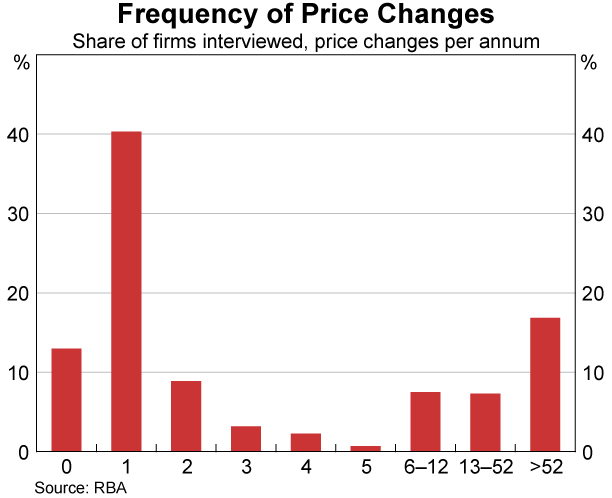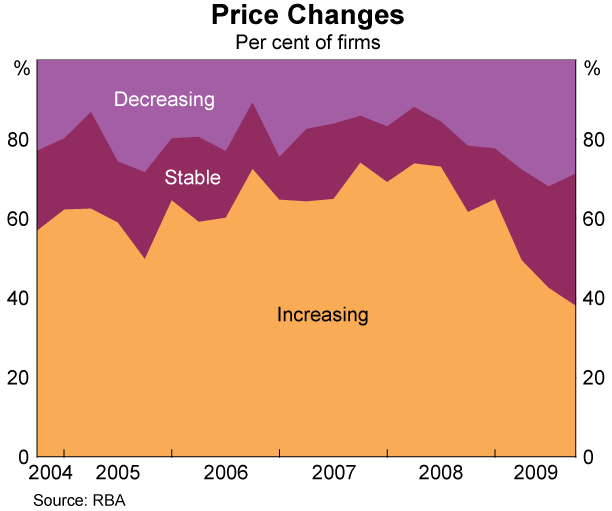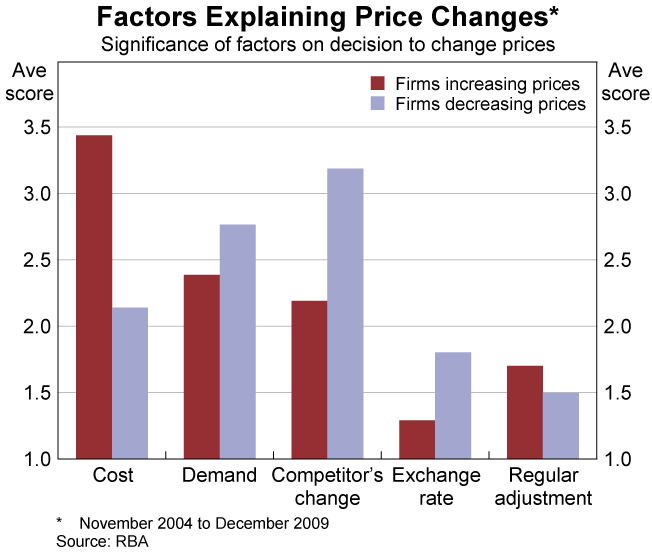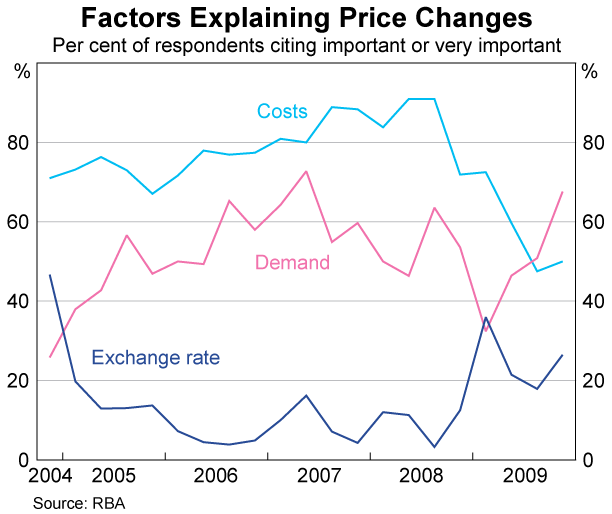Bulletin – June 2010 Price-setting Behaviour – Insights from Australian Firms
- Download the article 259KB
Abstract
Since 2004, the RBA has been conducting a survey of how firms set prices, how frequently they review and change prices, and what factors influence these decisions. The results show that firms employ a range of approaches to price setting, with around half reviewing their prices at a regular interval. Early in the survey period, costs were the most important factor in price setting, though demand considerations became more important when economic conditions softened.
Introduction
The way firms set prices can be a key determinant of the dynamics of the inflation process. Given this, over recent years a number of central banks, including the Reserve Bank of Australia (RBA), have conducted surveys of how firms set prices, how frequently they review and change their prices, and what factors influence these decisions.[1] This article discusses the results of an ongoing survey that has been conducted by the RBA since 2004.
The main findings can be summarised as follows:
- the surveyed firms employed a range of approaches to price setting, with slightly more setting prices as a mark-up on costs rather than in response to various demand factors;
- broadly the same number of surveyed firms reviewed prices at regular intervals (most commonly annually) as reviewed prices with each transaction or in response to external factors, although behaviour differs across sectors; and
- costs were the most important driver of price adjustment over the first part of the sample period, with demand considerations becoming more important when economic conditions softened in late 2008.
The Survey
The RBA has been surveying firms about the way they set prices since 2004. The survey has been conducted in two parts. The first was undertaken over an 18-month period from late 2004, with around 700 firms responding to a detailed set of specific questions about their pricing strategies, the timing of price reviews and adjustments, and the reasons for these adjustments. Questions about the factors influencing pricing decisions have been continued into the second part of the survey, which has run on an ongoing basis, involving around 60 firms each quarter. The survey has covered both ‘large’ firms (with more than 200 employees) and ‘small to medium’ firms (with less than 200 employees) across a wide range of industries (Table 1).
| Per cent of firms surveyed | Share of gross value added in GDP | |
|---|---|---|
| Industry sector(a) | ||
| Agriculture | 2 | 3 |
| Construction | 13 | 8 |
| Manufacturing | 28 | 14 |
| Mining | 4 | 3 |
| Utilities | 2 | 3 |
| Wholesale & retail trade | 17 | 13 |
| Transport & storage | 7 | 6 |
| Business services | 21 | 27 |
| Household services | 3 | 20 |
| Tourism | 3 | 4 |
| Firm size(b) | ||
| Small to medium | 34 | 49 |
| Large | 66 | 51 |
|
(a) Industry shares are calculated using a five-year average of the ratio
of industry gross value added to GDP(P), from June 2001 to June 2006.
Sources: ABS, RBA |
||
In the survey conducted from 2004–2006, firms were asked to identify the most significant influence on their price setting. In a similar fashion to surveys conducted by other central banks, firms were categorised into six broad groups, in particular firms that:
- predominantly used a cost plus fixed percentage mark-up;
- predominantly used a cost plus a variable percentage mark-up;
- set prices based on ‘general market conditions’;
- reported that ‘competitors’ prices' were the most important influence;
- reported that ‘the level of demand’ was the most important influence; and
- reported that the customer sets the price.
Firms were also asked how frequently prices were reviewed, in particular whether price reviews were conducted at a set frequency (‘time-dependent’) or whether prices were fixed until there was a sufficiently large change in market conditions (‘state-dependent’). In order to assess the frequency of price changes, the survey asked how many times the firm adjusted prices in the previous 12 months. Further, to explore the reasons for price changes, the survey asked firms to identify the relative significance of a list of factors in driving price changes. These included: costs, demand, competitor price movements, exchange rate movements and regular adjustments. (This question has been continued beyond 2006, which enables an assessment of how pricing behaviour has adjusted to changes in economic conditions as outlined in the final section of this article.) In addition, firms were asked if they offer ‘regular discounts’, such as a routine percentage reduction for larger customers, or if they offer ‘discounts that vary with market conditions’. Finally, the structural characteristics of each firm were also recorded, as well as their exposure to domestic and external competition.
Survey Results
How are prices determined?
When asked to describe how prices are set, one-half of the firms surveyed during the 2004–2006 period indicated that internal cost considerations were the most significant factor, while almost as many indicated that pricing decisions were driven primarily by demand factors. Of the firms that predominantly focused on cost factors, around half reported that they set prices as a fixed mark-up over costs, while the rest reported they set prices based on costs plus a margin that varies in line with demand conditions (Table 2).
| Per cent of firms | |
|---|---|
| More cost-focused | 49 |
| Cost plus fixed mark-up | 23 |
| Cost plus variable mark-up | 26 |
| More demand-focused | 45 |
| Market conditions | 25 |
| Competitors' prices | 11 |
| Level of demand | 4 |
| Customer sets price | 5 |
| Other | 6 |
|
Source: RBA |
|
The survey results suggest that pricing strategies differed significantly across industries (Table 3). Cost-focused strategies were dominant for the construction and transport & storage industries. This is not surprising given that during the first part of the survey period the construction industry was operating close to full capacity, so increases in costs were swiftly passed into prices. In contrast, pricing was more demand-focused in the commodity-producing agriculture and resource industries. In these industries, global demand factors were particularly important in determining prices. Similarly, demand-focused pricing dominated in the tourism industry; for example, accommodation prices and airfares were often quick to respond to changes in demand. A relatively high proportion of firms in the utilities and household services industries reported ‘other’ pricing strategies, consistent with the significance of price regulation in these sectors.
| Cost-focused(a) | Demand-focused(b) | Other | |
|---|---|---|---|
| Total sample | 49 | 45 | 6 |
| Industry(c) | |||
| Agriculture | 18 | 82 | 0 |
| Construction | 71 | 27 | 2 |
| Manufacturing | 47 | 46 | 6 |
| Mining | 18 | 71 | 11 |
| Utilities | 18 | 27 | 55 |
| Wholesale & retail | 44 | 50 | 7 |
| Transport & storage | 57 | 30 | 13 |
| Business services | 55 | 44 | 1 |
| Household services | 35 | 30 | 35 |
| Tourism | 20 | 80 | 0 |
| Firm size(c) | |||
| Small to medium | 56 | 42 | 2 |
| Large | 46 | 45 | 9 |
| Import competition(c) | |||
| Significant | 33 | 62 | 4 |
| Moderate | 54 | 39 | 7 |
| Minor | 50 | 41 | 8 |
|
(a) Sum of ‘direct cost-plus fixed mark-up’ and ‘direct
cost-plus variable mark-up’ categories. Source: RBA |
|||
In terms of the structural characteristics of the surveyed firms, those exposed to a larger degree of import competition tended to use more demand-focused approaches to price setting. In terms of size, cost-focused approaches were more common among smaller firms; this may be because it is costly to gather the information required to review prices, encouraging smaller firms to use a simple cost-plus mark-up approach.[2]
In response to the questions about discounting, around 40 per cent of firms said they undertook some type of significant discounting, with around one-quarter of all firms using discounting to manage fluctuations in market conditions. Larger firms were a little more likely to discount and had a higher tendency to vary discounts as market conditions change (Table 4). Discounting was also more prevalent among firms exposed to a higher degree of import competition, and among firms that used demand-focused pricing strategies.
| Standard discounts | Discounts on market conditions |
No significant discounts |
|
|---|---|---|---|
| Firm size(a) | |||
| Small to medium | 16 | 22 | 62 |
| Large | 13 | 31 | 57 |
| Import competition(a) | |||
| Significant | 21 | 40 | 38 |
| Moderate | 17 | 22 | 60 |
| Minor | 12 | 24 | 64 |
| Pricing strategy(a) | |||
| Cost-focused | 13 | 24 | 63 |
| Demand-focused | 16 | 34 | 50 |
|
(a) A chi-squared test of independence between the firm characteristic (rows) and pricing behaviour (columns) was conducted. The null hypothesis of no relationship was rejected at the 5 per cent level of significance. Source: RBA |
|||
How often are prices reviewed?
Around half of the surveyed firms reviewed prices at a set frequency (‘time-dependent’)(Table 5). This is lower than the shares reported in international pricing studies.[3] The most commonly reported frequency was annual, while less than 15 per cent of firms conducted reviews monthly or weekly. This result suggests that for many firms the cost of conducting frequent reviews is greater than the expected benefit, particularly during a period of relatively stable demand and inflation.
| Per cent of firms | |
|---|---|
| State-dependent | 29 |
| For each transaction | 25 |
| Time-dependent | 46 |
| Annually | 23 |
| Semi-annually | 6 |
| Quarterly | 6 |
| Monthly | 7 |
| Weekly | 4 |
|
Source: RBA |
|
Around one-quarter of firms reviewed prices for each transaction, with the large majority of these firms in the business services and construction industries. Of those firms, the most common trigger for a review was a change in costs (cited by nearly 30 per cent of firms), consistent with the dominance of cost-focused pricing models in these industries.
How often are prices changed?
Around 40 per cent of firms reported that they had changed prices once over the previous 12 months (Graph 1).[4] Just 15 per cent of firms did not change prices at all. At the other end of the spectrum, about 25 per cent of firms reported changing prices more than once a month in the previous year.

Price changes were most frequent in the goods sector, with a median of two price changes in a 12-month period (Table 6). The median frequency of price changes was similar for both small and large firms, although a higher proportion of large firms changed their prices more than once a week. This is consistent with the administrative and management costs associated with the price-setting process being particularly high for small firms, resulting in fewer price reviews and price changes.
| Median | Median | ||
|---|---|---|---|
| Sectors* | Firm size | ||
| Goods production | 2 | Small to medium | 1 |
| Goods distribution | 2 | Large | 1 |
| Services | 1 | ||
| Market share* | Labour costs* | ||
| Less than 20 per cent | 2 | Less than 20 per cent | 3 |
| 20–40 per cent | 2 | 20–50 per cent | 2 |
| Greater than 40 per cent | 1 | Greater than 50 per cent | 1 |
| Domestic competition* | Material costs* | ||
| Significant | 2 | Less than 20 per cent | 1 |
| Moderate | 1 | 20–50 per cent | 2 |
| Minor | 1 | Greater than 50 per cent | 3 |
| Import competition | Imported costs** | ||
| Significant | 2 | Less than 20 per cent | 1 |
| Moderate | 2 | 20–50 per cent | 2 |
| Minor | 1 | Greater than 50 per cent | 3 |
|
(a) A Kruskal-Wallis rank sum test of the equality of medians was conducted. * and ** indicate rejection of the null hypothesis at the 10 and 5 per cent levels, respectively. Source: RBA |
|||
The nature of firms' costs also appeared to influence the frequency of price changes. Firms with imported input costs accounting for a high share of total costs reported more frequent price changes and reviews than those with a lower share. A similar pattern was apparent for material costs. The share of labour costs had the opposite effect on the frequency of price adjustments and reviews, consistent with material costs and imported costs being more volatile than labour costs.
How Do Pricing Decisions Vary with Economic Conditions?
The first part of the pricing survey provided some stylised facts about the price-setting process used by Australian firms. The second part of the survey provides some insights into how pricing behaviour varies with economic conditions.
According to the survey results, the share of firms raising their prices increased gradually through much of the past decade, up until the second half of 2008, when firms started to report a moderation in inflationary pressures (Graph 2). Reflecting this change, in both 2008 and 2009 the share of firms cutting prices was significantly higher than in previous years.

As part of the ongoing survey, firms were asked why they changed their prices, and to indicate the importance of five factors – demand, costs, competitors' price moves, exchange rate movements and regular price adjustments – on a scale from unimportant (a score of 1) to very important (a score of 4). The relative importance of each of the five factors was different for firms raising prices and firms lowering prices (Graph 3). Cost changes were significantly more important for firms increasing prices. On the other hand, competitors' price changes and exchange rate movements were relatively more important in explaining price decreases than price increases. The importance of demand conditions was broadly balanced for firms increasing or decreasing prices.

The relative importance of factors explaining price changes has varied over time: from late 2004 until mid 2007, the share of respondents reporting cost pressures and strong demand growth as important factors explaining price changes gradually increased, though cost pressures remained the dominant factor (Graph 4). While the share of firms citing cost pressures continued to drift higher into 2008, demand growth became a less important factor. But from early 2009 when the slowdown in economic growth resulted in a moderation in inflationary pressures, an increasing number of firms cited demand factors as a reason to lower prices. The exchange rate also became a more important consideration in late 2008, in line with the large depreciation of the Australian dollar, and the subsequent appreciation in 2009.

Conclusion
The results of the Reserve Bank's pricing survey suggest that the key drivers of price changes vary both amongst different types of firms and over time. In general, around half of the surveyed firms use a cost-plus mark-up approach to price setting while the other half reported that they respond more to market conditions. Many firms also appear to review prices at a regular interval, typically on an annual basis. Price reviews and changes tend to be more frequent for those firms in the goods sector. These results are broadly consistent with the findings of similar studies in other countries.
The RBA survey also indicated that firms' price-setting behaviour changed somewhat during the recent economic slowdown, with demand factors becoming a more important determinant of price-setting decisions. Through 2009, the share of firms highlighting the importance of demand factors when setting prices increased significantly, whereas the share of firms citing the importance of cost factors fell by one-third. In general, cost pressures were found to be relatively more important for firms raising prices, whereas demand conditions, competitors' price decreases and exchange rate movements were relatively more important for firms during periods in which they were lowering prices.
Footnotes
Anna Park and Vanessa Rayner are from Economic Analysis Department; Patrick D’Arcy is from International Department. [*]
Following the initial study in the United States (Blinder et al 1998), price-setting surveys have been conducted by the central banks of Canada, England, Japan, Sweden and New Zealand, as well as a number of euro area central banks. [1]
These two findings are consistent with the euro area central banks' survey results presented in Fabiani et al (2006), that find the lower the level of competition, or the smaller the firm, the more likely mark-up pricing is used. [2]
For example, for the United States and the United Kingdom, Blinder et al (1998) and Hall, Walsh and Yates (2000) find that 60 per cent and 79 per cent of firms followed time-dependent rules. For the euro area economies Fabiani et al (2006) ask a slightly different question, and find that most firms follow both time-dependent and state-dependent rules. [3]
For questions on the frequency of price reviews and changes where the firm has multiple product lines, the survey asked the firm to focus on their major product category. [4]
References
Blinder AS, ERD Canetti, DE Lebow and JB Rudd (1998), Asking about Prices: A New Approach to Understanding Price Stickiness, The Russell Sage Foundation, New York.
Fabiani S, M Druant, I Hernando, C Kwapil, B Landau, C Loupias, F Martins, T Mathä, R Sabbatini, H Stahl and A Stokman (2006), ‘What Firms’ Surveys Tell Us about Price-Setting Behavior in the Euro Area’, International Journal of Central Banking, 2(3), pp 3–47.
Hall S, M Walsh and A Yates (2000), ‘Are UK Companies' Prices Sticky?’, Oxford Economic Papers, 52(3), pp 425–446.